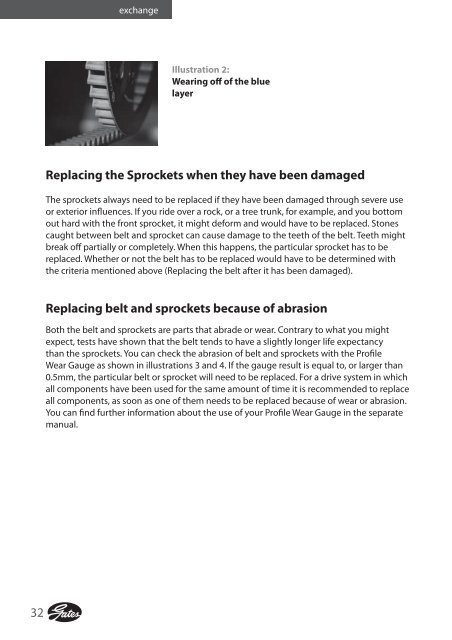General Information Gates/Rohloff - Koga Signature
General Information Gates/Rohloff - Koga Signature General Information Gates/Rohloff - Koga Signature
exchange Illustration 2: Wearing off of the blue layer Replacing the Sprockets when they have been damaged The sprockets always need to be replaced if they have been damaged through severe use or exterior influences. If you ride over a rock, or a tree trunk, for example, and you bottom out hard with the front sprocket, it might deform and would have to be replaced. Stones caught between belt and sprocket can cause damage to the teeth of the belt. Teeth might break off partially or completely. When this happens, the particular sprocket has to be replaced. Whether or not the belt has to be replaced would have to be determined with the criteria mentioned above (Replacing the belt after it has been damaged). Replacing belt and sprockets because of abrasion Both the belt and sprockets are parts that abrade or wear. Contrary to what you might expect, tests have shown that the belt tends to have a slightly longer life expectancy than the sprockets. You can check the abrasion of belt and sprockets with the Profile Wear Gauge as shown in illustrations 3 and 4. If the gauge result is equal to, or larger than 0.5mm, the particular belt or sprocket will need to be replaced. For a drive system in which all components have been used for the same amount of time it is recommended to replace all components, as soon as one of them needs to be replaced because of wear or abrasion. You can find further information about the use of your Profile Wear Gauge in the separate manual. 32
exchange Profile Wear Gauge Illustration 3: Checking the abrasion of the belt 3 Belt Profile Wear Gauge Illustration 4: One-sided abrasion upon the teeth of the rear sprocket rear sprocket Please note: Small cracks on the back of the belt may occur after some amount of use. These are normal. If there are cracks at the dedendum (the radial distance between the pitch circle and the bottom of the tooth), however, the belt will need to be replaced. www.carbondrivesystems.com 33
- Page 1 and 2: Manual for the Gates Carbon Drive S
- Page 3 and 4: 1 first steps • Congratulations!
- Page 5 and 6: first steps 1 Have your bike checke
- Page 7 and 8: first steps 1 Mounting the tensione
- Page 9 and 10: first steps 1 7. 8. 1. Drive belt n
- Page 11 and 12: mounting Mounting the Gates Carbon
- Page 13 and 14: mounting 2 Illustration 3: Correct
- Page 15 and 16: mounting Checking the belt tension
- Page 17 and 18: mounting Checking the belt tension
- Page 19 and 20: mounting axle. If the Snubber is lo
- Page 21 and 22: mounting 2 Shim ring for bottom bra
- Page 23 and 24: mounting Mounting the Gates Carbon
- Page 25 and 26: mounting Lubricate the inner thread
- Page 27 and 28: mounting Ensure that the surfaces o
- Page 29 and 30: mounting Removing the Gates-Rohloff
- Page 31: exchange When does the Gates Carbon
- Page 35 and 36: for Frame builders Frame requiremen
- Page 37 and 38: 5 Gear Ratio Comparisum • Compari
- Page 39 and 40: atio overview 19 Teeth rear 20 Teet
- Page 41 and 42: atio overview Sprocket-size combina
- Page 43: Find more information for Europe: U
exchange<br />
Illustration 2:<br />
Wearing off of the blue<br />
layer<br />
Replacing the Sprockets when they have been damaged<br />
The sprockets always need to be replaced if they have been damaged through severe use<br />
or exterior influences. If you ride over a rock, or a tree trunk, for example, and you bottom<br />
out hard with the front sprocket, it might deform and would have to be replaced. Stones<br />
caught between belt and sprocket can cause damage to the teeth of the belt. Teeth might<br />
break off partially or completely. When this happens, the particular sprocket has to be<br />
replaced. Whether or not the belt has to be replaced would have to be determined with<br />
the criteria mentioned above (Replacing the belt after it has been damaged).<br />
Replacing belt and sprockets because of abrasion<br />
Both the belt and sprockets are parts that abrade or wear. Contrary to what you might<br />
expect, tests have shown that the belt tends to have a slightly longer life expectancy<br />
than the sprockets. You can check the abrasion of belt and sprockets with the Profile<br />
Wear Gauge as shown in illustrations 3 and 4. If the gauge result is equal to, or larger than<br />
0.5mm, the particular belt or sprocket will need to be replaced. For a drive system in which<br />
all components have been used for the same amount of time it is recommended to replace<br />
all components, as soon as one of them needs to be replaced because of wear or abrasion.<br />
You can find further information about the use of your Profile Wear Gauge in the separate<br />
manual.<br />
32



